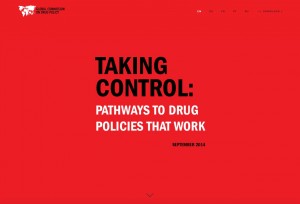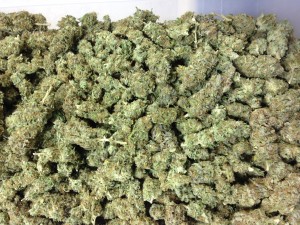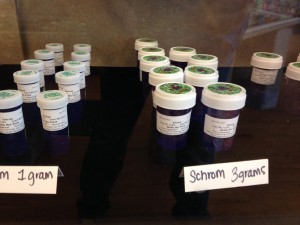Report by global leaders supports legalizing, regulating drugs
I finally got time to read the September 2014 report by the Global Commission on Drug Policy (GCDP) called “Taking Control: Pathways to Drug Policies That Work.”
The report comes from some heavy hitters internationally, including Kofi Annan, former United Nations secretary general, Louise Arbour, former UN High Commissioner for Human Rights, and former presidents and prime ministers of several countries. It also includes George Shultz, former U.S. secretary of state, Paul Volcker, former chairmen of the U.S. Federal Reserve, and John Whitehead, former U.S. deputy secretary of state.
Interesting how often the word “former” appears in the list – perhaps it’s safer for them to support marijuana and other drug reform now that they’re no longer in power.
The report notes that the global “War on Drugs” has failed miserably, and it looks at the possibility of a more compassionate approach to drug policy. The suggestions involve policies that protect human health instead of classifying drug users as criminals.
One thing it supports is looking at a variety of approaches for legalization. Here’s one such recommendation in the executive summary:
“Allow and encourage diverse experiments in legally regulating markets in currently illicit drugs, beginning with but not limited to cannabis, coca leaf and certain novel psychoactive substances: Much can be learned from the successes and failures of regulating alcohol, tobacco, pharmaceutical drugs and other products and activities that pose health and other risks to individuals and societies. New experiments are needed in allowing legal but restricted access to drugs that are now only available illegally. This should include the expansion of heroin-assisted treatment for some long-term dependent users, which has proven so effective in Europe and Canada. Ultimately the most effective way to reduce the extensive harms of the global drug prohibition regime and advance the goals of public health and safety is to get drugs under control through responsible legal regulation.”
Interesting to note that the drugs of interest for broader loosening of restrictions include more than just cannabis, but also coca leaf and some psychedelic drugs.
As far as overall drug use and policy, the report suggests it could be more beneficial to look at drugs on an individual basis.
Here’s an excerpt about that:
“In reality, the use of drugs encompasses a wide spectrum of behaviors. These range from the non-problematic to the compulsive and profoundly harmful. According to the UNODC, 10 percent of people who use drugs globally are considered to be ‘problem users.’ This suggests that the significant majority of drug consumption is essentially non-problematic. Yet global drug policy continues to treat all drug use as if it constitutes a grave threat to society. Drug policy remains narrowly framed in terms of ‘combating the evil’ of drug addiction.”
It continues:
“It is from this initial, flawed generalization of all drug use as an ‘evil’ to be tackled with repressive criminal justice-based measures that so many irrational and ineffective policy responses have flowed, and so many dysfunctional institutions have emerged. These easy simplifications contribute to political decisions that are divorced from basic scientific, public health and human rights norms. At the heart of the Global Commission’s recommendations, then, is a call for realigning global drug policy with these basic standards.”
The report notes that the war on drugs has failed because, among other things:
- It has wasted billions of dollars on policies that turn ordinary citizens into criminals
- It has undermined international and regional security by creating violent underground markets that often profit paramilitary groups
- It undermines human rights by leading to the incarceration and even death penalty killing of people who use substances.
And, it says, regulation and legalization under government control is a more effective way to protect the public.
In part, it says:
“The regulation of drugs should be pursued because they are risky, not because they are safe. Different models of regulation can be applied for different drugs according to the risks they pose. In this way, regulation can reduce social and health harms and disempower organized crime.”
On cannabis, it continues:
“Around the world, the debate about the legal regulation of cannabis – and potentially other drugs – is moving into the mainstream. The discussion is no longer a purely theoretical one: multiple jurisdictions are developing and implementing models of legal cannabis regulation, and regulatory approaches for other drugs are also emerging. Parliamentarians, mayors, businessmen, physicians, educators, civil society and religious leaders are openly welcoming the debate around drug policy reform and the need to experiment. Now that the taboo around regulation is broken, it is important to dispel any misconceptions and clarify what it means in practice. There is no simple blueprint for drug regulation.”
One of the report’s key recommendations is to allow diverse experiments in creating legal recreational markets – such as those here in Washington and in Colorado.
It also includes a list of five examples of drug regulation models that could be used for various substances:
Medical prescription model: “The riskiest drugs, such as injectable heroin, are prescribed by qualified and licensed medical professionals to people who are registered as dependent on drugs. Swiss heroin clinics are a prominent working example of this model.”
Specialist pharmacy model: “Licensed medical professionals serve as gatekeepers to a range of drugs, facilitating over the counter sales. Additional controls, such as licensing of purchasers or sales rations, can also be implemented. This is the model adopted for retail sales of cannabis in Uruguay.”
Licensed retail model: “Licensed outlets sell lower-risk drugs in accordance with strict licensing conditions that can include controls on price, marketing, sales to minors, and mandated health and safety information on product packaging. Less restrictive examples of this model include off-licenses, tobacconists or front of counter sales in pharmacies.”
Licensed premises model: “Similar to pubs, bars or cannabis ‘coffee shops,’ licensed premises sell lower-risk drugs for on-site consumption, subject to strict licensing conditions similar to those for licensed retail.”
Unlicensed retail model: “Drugs of sufficiently low risk, such as coffee or coca tea, require little or no licensing, with regulation needed only to ensure that appropriate production practices and trading standards are followed.”
If you’re interested, give the full report a read. There’s a lot more in there than what I’ve highlighted. The full report is available here: Taking Control: Pathways to Drug Policies That Work.
Cheers,
-SueVo (sue.vorenberg@columbian.com)




